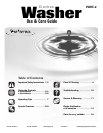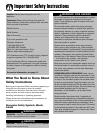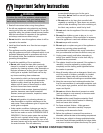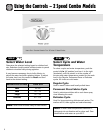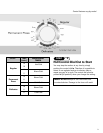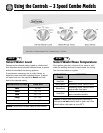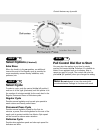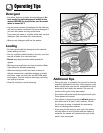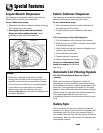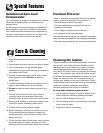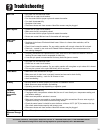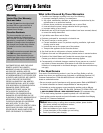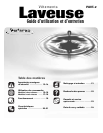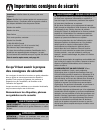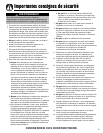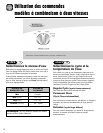
2
1. Read all instructions before using the appliance.
2. As with any equipment using electricity and having
moving parts, there are potential hazards. To use this
appliance safely, the operator should become familiar
with the instructions for operation of the appliance
and always exercise care when using it.
3.
Do not install or store this appliance where it will be
exposed to the weather.
4. Install and level washer on a floor that can support
the weight.
5. This appliance must be properly grounded. Never
plug the appliance cord into a receptacle which is not
grounded adequately and in accordance with local
and national codes. See installation instructions for
grounding this appliance.
6. To avoid the possibility of fire or explosion:
a.
Do not wash items that have been previously
cleaned in, washed in, soaked in, or spotted with
gasoline, dry-cleaning solvents, other flammable or
explosive substances as they give off vapors that
could ignite or explode. Hand wash and line dry
any items containing these substances.
Any material on which you have used a cleaning
solvent, or which is saturated with flammable
liquids or solids, should not be placed in the
washer until all traces of these liquids or solids
and their fumes have been removed.
These items include acetone, denatured alcohol,
gasoline, kerosene, some liquid household
cleaners, some spot removers, turpentine, waxes
and wax removers.
b.
Do not add gasoline, dry-cleaning solvents, or
other flammable or explosive substances to the
wash water. These substances give off vapors that
could ignite or explode.
c.
Under cer
t
ain conditions, hydrogen gas may be
produced in a hot water system that has not been
used for two weeks or more. HYD
R
O
G
E
N G
AS IS
E
XPLOSIVE. If the hot water system has not been
used for such a period, before using a washing
machine or combination washer-dryer
, turn on all
hot water faucets and let the water flow from each
for several minute
s. T
his will release any
To reduce the risk of fire, explosion, electric shock,
or personal injury when using your washer, follow
basic safety precautions, including the following:
WARNING
accumulated hydrogen gas. As the gas is
flammable, do not smoke or use an open flame
during this time.
d. Do not wash or dry items that are soiled with
vegetable or cooking oil. These items may contain
some oil after laundering. Due to the remaining oil,
the fabric may smoke or catch fire by itself.
7. Do not reach into the appliance if the tub or agitator
is moving.
8.
Do not allow children or pets to play on, in, or in
front of the appliance. Close supervision is necessary
when the appliance is used near children and pets.
9.
Do not tamper with controls.
10.
Do not repair or replace any part of the appliance or
attempt any servicing unless specifically
recommended in published user-repair instructions
that you understand and have the skills to carry out.
11. Unplug power supply cord before attempting to
service your washer. Service is to be done only by
qualified service personnel.
12. The agit
ator should not be removed. If the agitator is
removed, it must be replaced by pushing down
completely and the locking screw tightened before
the washer is operated.
13. Keep all laundry aids such as detergents, bleach, etc.,
out of the reach of children, preferably in a locked
cabinet. Use laundry aids only as directed by the
manufacturer. Observe all warnings on container labels.
14. Keep the area around and underneath washer free
from the accumulation of combustible materials, such
as lint, paper, rags, gasoline, and all other flammable
vapors and liquids.
15.
Do not use chlorine bleach and ammonia or acids
(such as vinegar or rust remover) in the s
ame wash.
Hazardous fumes can form.
16. Do not machine wash fiberglass materials. Small
particles can stick to fabrics washed in following
loads and c
ause skin irrit
ation.
17. For flame resistant finishes - follow garment
manufacturer's instructions carefully. Improper
laundering could remove the finish.
18. Before the appliance is removed from service or
disc
arded, remove the door to the washing compar
tment.
19. Inlet hoses are subject to damage and deterioration
over time. Check the hoses periodically for bulges, kinks,
cuts, wear or leaks and replace them every five years.
C
ycles, options, lights
W
hat can & cannot be
washed
o
perating tips
dishwasher use
loading
Controls at a glance
Dryer Exhaust tips
S
afety
Care & Cleaning
Service & Warranty
S
urface Cooking
troubleshooting
Oven Cooking
Storing the washer
Installation
S
pecial Features
Notes
Important Safety Instructions
C
ycles, options, lights
What can & cannot be
w
ashed
operating tips
dishwasher use
l
oading
Controls at a glance
Dryer Exhaust tips
Safety
C
are & Cleaning
Service & Warranty
S
urface Cooking
troubleshooting
Oven Cooking
Storing the washer
Installation
S
pecial Features
Notes
SAVE THESE INSTRUCTIONS



